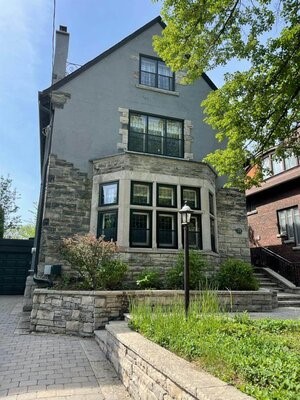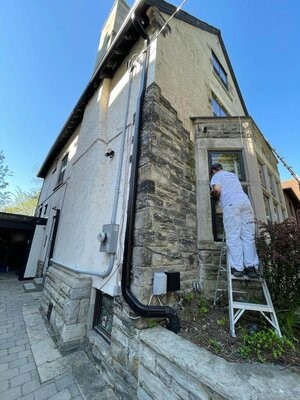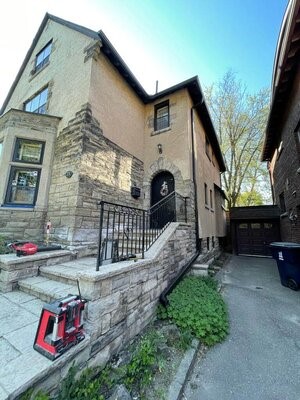What is paint sheen?
For those looking to paint the exterior of a home, deciding which sheen or finish to use is just as important as picking a colour. Differing in both appearance and performance, paint sheen comes in four main groups: flat or matte, satin (also known as eggshell), semi-gloss, and gloss, with gloss being very shiny, reflecting light, and a matte paint sheen being dull, absorbing light. To create certain levels of sheen, paint manufacturers change the ratio of resin and binders to pigment levels in the paint. In a paint with a high sheen like semi-gloss or gloss, the levels of resin and binders are high. By contrast, paints with a high level of pigments are less shiny and reflective.

But in addition to appearance, sheen also affects a paint’s performance. The exterior of your home is constantly undergoing stress from rain, snow, wind, and UV rays, so it is critical to choose the paint that not only has the look you’re going for, but one that is durable enough for the job. High gloss paints are more durable, better at resisting moisture and wear and tear, whereas duller paint sheens attract more dirt and are more susceptible to the elements. However, every type has its place, so it’s important to understand the different role each plays when selecting paint for the exterior of your home.
Flat Vs. Satin Finish Paint
Now that we know what paint sheen is, let’s discuss the different strengths of each group, starting on the less reflective end of the spectrum. Though we know that flat or matte sheen is less resistant to the elements, there are many advantages to using this type of paint. It is totally unreflective, and as a result is very good at hiding any flaws in a surface, or any inconsistencies in application, such as overlapping brush strokes. In a paint with a high gloss finish for example, the shiny, reflective surface would highlight these. So consider this: are you doing the painting yourself? If so, unless you are a professional painter, using a paint with a matte finish can be useful in hiding any inconsistencies you may create. As well, the rough texture and soft appearance gives it a contemporary feel, which can modernize any home.




However, in addition to being less durable, there are a few other things to keep in mind when considering matte paint. First of all, it is very hard to clean. The rough surface is both good at trapping dirt as well as making it difficult to scrub out. So unless you plan on using a pressure washer, the best solution is to put on another coat. As well, the paint flakes off more easily than paints with higher gloss. With this in mind, be prepared to repaint more often if you are using matte or flat paint.
Moving up one level to satin/eggshell finish, these paints have their own strengths and considerations compared to those with a flat finish. Like matte paints, they are somewhat rough, but with an almost waxy feel. The slight shine also gives the paint a lustre that you won’t get from a matte finish. As for performance, being only one step above matte finishes in terms of how reflective they are, an eggshell finish also does a good job at hiding imperfections. Unlike matte paints however, satin paints are easy to wipe clean, and are more resistant to the elements. As a result, a satin paint finish will generally last longer than a matte one.
However, though satin finishes hide imperfections, you do need to take more care than with matte finishes, as the more shiny a paint is, the more imperfections will stand out. As well, more than matte finishes, it’s essential to mix the paint thoroughly before every session in order to avoid the resins and pigments from separating. Otherwise, the sheen will be uneven. If you go with satin paints, be sure to have the paint thoroughly mixed at the store before painting!
Is satin paint better than gloss?
Moving to the more reflective and resilient paints, gloss and high gloss paints are great in some situations, but there are a few things to keep in mind. As we’ve talked about, increasing the level of gloss increases the durability of a paint, so glossy paints are great for areas that will get a lot of wear, like a door. As well, in terms of appearance, because of how reflective they are, glossy paints are perfect for accenting features of your home, such as window frames or gutters. Painting the entire exterior of your home with a rich, reflective high gloss paint would be a bold design move, but depending on the vision you have for your home, this could be exactly what you’re looking for! But remember, this level of gloss will highlight every imperfection if not properly done.
So is satin better than gloss? There aren’t any strict rules, but in general satin paints will tick off most of the boxes that a homeowner is looking for. They are easy to work with, resistant to the elements, easy to clean, and will give your home an attractive shine without being too overbearing. But every home is different! Do you want a modern look and don’t mind the occasional touch up? Go with matte paint. If your home’s exterior paint job will be subjected to a lot of wear and tear or if you want to make a strong design statement, use high gloss paint on more than just accents. The important thing is to go with the paint that suits the needs of your home and meets your vision for it.
For more information about what paints to choose and how to use them, be sure to check out the rest of Encore Painting, and if you want to leave the painting to the pros, get a free painting estimate today.